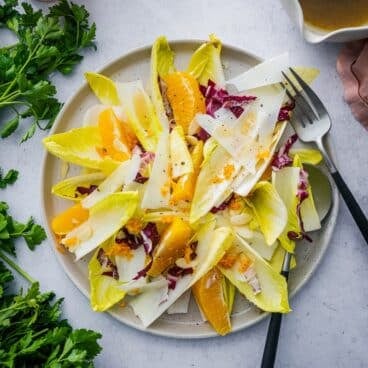Looking for a salad with sophistication? Try endive! Endive is a leafy vegetable with a small cylindrical head, related to other bitter greens like radicchio and escarole. Take one bite and it’s got a crisp, hydrating burst with a bitter finish. Endive is often used in salads, but its cup shaped leaves make it ideal for scooping up creamy dips, too. Here’s a bit more about this leafy green and our top ways to use it in recipes!
Types of endive
Belgian endive has an interesting backstory: it was “discovered” in 1830 by a Belgian farmer. Jan Lammers left some chicory roots in his cellar for a few months, and found that they sprouted tender, crunchy leaves. This “new” vegetable is simply another form of chicory, but it went on to become very popular in Europe. There are a few varieties of endive you can find at the store when shopping. Here’s what to know:
White endive (Belgian endive): This variety has a cylindrical head with creamy white leaves that taste crunchy and subtly bitter. Red endive: This variety is a cross between radicchio and white endive, and tastes milder and less bitter than white endive. Curly endive (frisee or endive lettuce): Frisée is a type of endive, but it looks completely different! It’s green with frilly, ruffled leaves and an even milder flavor. Broad leaf endive (escarole): Escarole has broader, curly green leaves and the mildest flavor of the varieties.
Buying and storing endive
What to look for when you’re buying endive at the store? Here’s what to know:
Look for a firm head with compact, creamy white leaves. Only the two outer leaves should be visible. Avoid soft heads with green leaves or browned ends. Store Belgian endive refrigerated for 5 to 7 days, in a loosely closed plastic bag or wrapped in a damp cloth. Store frisee and escarole refrigerated for 5 days, unwashed and wrapped in paper towel in a plastic bag. Wash before serving.
Should endive be washed?
Endive does not need to be washed before serving. Simply wipe down the outer leaves with a cloth (or remove and discard them). Why? The leaves haven’t been exposed to soil, and they’re packed in sanitary conditions (source). That makes this leafy green one of the easiest to work with.
Endive recipes
Endive is most often eaten raw, but it can also be cooked! It’s great in salads, and the cup-like leaves are great for dipping into creamy dips. Or, stuff the leaves with goat cheese as a simple appetizer. It can also be braised and topped with herbs or a bechamel sauce. Here are a few recipe ideas: More quick guides? Try Quick Guide to Butter Lettuce, Quick Guide to Romaine and Quick Guide to Frisee. 5 from 1 review







